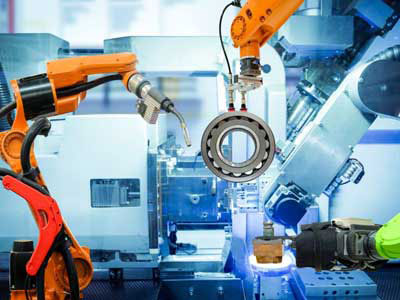Key Takeaway
The first industrial robot is named Unimate. Unimate began working on a General Motors assembly line at the Inland Fisher Guide Plant in Ewing Township, New Jersey, in 1961. This groundbreaking robot was designed to handle dangerous and repetitive tasks, improving both safety and efficiency in manufacturing. Unimate’s success paved the way for the development of modern industrial robotics, revolutionizing the way factories operate. Its introduction marked the beginning of automation in industrial applications, showcasing the potential of robots in enhancing productivity and precision.
Historical Background
Back in the 1950s, a groundbreaking invention changed manufacturing forever: the birth of the first industrial robot. Developed by George Devol and Joseph Engelberger, this mechanical marvel marked a pivotal moment in automation history. This innovation revolutionized production processes, enhancing efficiency and precision. Devol’s patent for the robotic arm, known as Unimate, laid the foundation for modern robotics. Engelberger, often called the “Father of Robotics,” helped commercialize this technology, leading to widespread adoption in various industries. The introduction of industrial robots has since transformed manufacturing, paving the way for advancements in automation and technology.

Development and Deployment
Imagine stepping into an industrial facility where large machines hum with efficiency, each one meticulously performing its designated task with precision and consistency. Among these marvels of modern engineering stands the industrial robot, a revolutionary invention that has transformed manufacturing processes worldwide.
Development of the First Industrial Robot
In the mid-20th century, the development of the first industrial robot marked a watershed moment in manufacturing history. Conceived out of necessity to handle hazardous and repetitive tasks, these early robots were not just machines but pioneers in automation. General Motors, a leader in automotive manufacturing, led the charge by deploying these robots on their assembly lines.
The genesis of these robots lay in their design: hydraulic arms capable of lifting and manipulating objects with unparalleled dexterity. Imagine a massive arm, akin to a colossal mechanical limb, moving seamlessly along a pre-programmed path. These robots were controlled initially by punched cards, a precursor to modern programming, and later by computer programs that enabled them to execute tasks with remarkable speed and accuracy.
The impact of these early robots was profound. They liberated human workers from dangerous tasks, reducing injuries and fatalities in industrial settings significantly. Moreover, by assuming monotonous roles, these robots allowed human labor to shift towards more intellectually demanding and creative responsibilities, thereby enhancing overall productivity and job satisfaction.
Key Features of the First Robot
What made these pioneering robots so revolutionary? At their core were hydraulic arms, robust and agile enough to handle a variety of tasks from lifting heavy components to delicately assembling intricate parts. Picture a massive, yet graceful arm, controlled by sophisticated programming that could perform delicate maneuvers with surgical precision.
Central to their operation was their method of control. Initially guided by punched cards, these robots later transitioned to computer programs. This shift enabled greater flexibility and responsiveness in their actions, as well as the ability to adapt swiftly to changing production needs. Imagine a machine capable of learning and refining its movements over time, becoming more efficient with each task it performed.
The introduction of these robots brought about a paradigm shift in manufacturing. They not only accelerated production processes but also set the stage for further advancements in automation and robotics. By streamlining operations and enhancing efficiency, they paved the way for the modern manufacturing landscape we see today, where automation is integral to driving productivity and innovation.
Impact on Industry
Industrial robots have revolutionized manufacturing, leaving a lasting impact on the industry. Initially introduced to streamline repetitive tasks, they quickly proved their worth by significantly boosting productivity across factory floors. Manufacturers witnessed a remarkable shift towards efficiency, as robots could work tirelessly without the limitations of human fatigue, ensuring round-the-clock operations.
Moreover, safety conditions saw marked improvements as robots took over hazardous jobs, reducing workplace accidents and enhancing employee well-being. This shift not only saved costs associated with injuries but also elevated overall operational safety standards, aligning with stringent regulatory requirements.
In terms of cost-effectiveness, the adoption of industrial robots led to substantial savings. By automating processes, companies minimized waste, optimized resource utilization, and trimmed down production expenses. This financial benefit allowed businesses to reinvest in innovation and expansion, fostering growth within the industrial sector.
Evolution Over Time
Fast forward to the present day, industrial robots have undergone a transformative evolution. From their humble beginnings, where they handled basic assembly tasks, they have evolved into sophisticated machines equipped with advanced sensors and artificial intelligence. These enhancements enable robots to perform intricate operations with precision and adaptability, surpassing human capabilities in certain tasks.
One of the most notable advancements is the integration of AI, which empowers robots to learn from their environment, make decisions autonomously, and even collaborate with human workers in shared workspaces. This collaborative approach, known as cobotics, enhances productivity by combining human dexterity and cognitive skills with robotic efficiency.
Furthermore, modern industrial robots are more versatile than ever before. They can switch between different tasks seamlessly, offering flexibility in production processes. This versatility not only optimizes resource allocation but also allows for rapid adaptation to changing market demands, keeping industries competitive on a global scale.
Conclusion
In conclusion, the first industrial robot was more than just a machine. It was a pioneer that revolutionized manufacturing. Its journey from concept to reality not only shaped industry standards but also set the stage for future innovations. As we look ahead, the legacy of these early robots reminds us of the endless possibilities that automation brings to the table.
